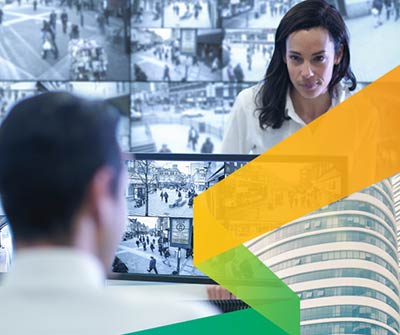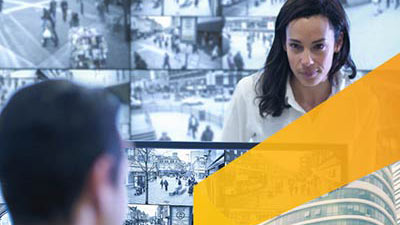Protecting Lives and Property
Get our expert’s insights

In an emergency, your network infrastructure is a lifeline. So, in planning and managing your building’s LAN network, you hope for the best but always plan for the worst. CommScope spoke with Ronna Davis, Lead Market Development, CommScope, for her thoughts on the relationship between network infrastructure and safety in the workplace.
Q: In listening to you talk about the connection between network infrastructure and safety, there is a sense of urgency in your voice.
In this business, I think it’s too easy to measure success and failure by throughput and productivity. Don’t get me wrong: That stuff is really important. But, when you read about catastrophic events inside the workplace that result in loss of life, you get a totally different perspective.
Q: So what are some of the connections between network infrastructure and safety?
There are many. The role of the enterprise LAN has grown to the point that most systems in the building are tied into the network. Many of those have a direct impact on personal and public safety—whether it’s helping to prevent a crisis or enabling first responders to react more quickly and effectively. From the structured cabling network to the multiple connected systems—like in-building wireless, building security and lighting—virtually every aspect of your building’s physical layer infrastructure plays a role in protecting lives and property.
Q: Since you mentioned in-building wireless, let’s start there. How do you see in-building wireless solutions evolving to promote a safer environment?
A big priority right now is ensuring support for dedicated public safety frequencies and systems, which vary based on country and region. For example, you’ve got terrestrial trunked radio or TETRA across most of Europe; China uses its native Police Digital Trunking (PDT) standard; while, here in the U.S., the LTE-based FirstNet® is now in deployment.
Q: Are these the remote “basement hackers” most people think about when they read about attacks?
Definitely not. According to the Ponemon Institute study, nearly half of all security breaches occur from inside the building by authorized users trying to gain access to unauthorized data or by visitors who are able to quietly slip into an empty office and plug into an Ethernet port.
Q: So, is in-building wireless support for these systems mandatory?
No, but coverage is. In fact, depending on where you are, it can be required in order to obtain occupancy or building permits—especially for large buildings where coverage from the macro or outdoor network is not available.
Q: And the outdoor macro network is unreliable indoors?
It can be. The RF signals have difficulty penetrating walls and low-e windows, so a resilient in-building wireless network is often a must-have—especially in areas like elevators, basements and underground parking garages.
Q: What other aspect of the network infrastructure has the biggest impact on safety?
I think you need to look at having a low-voltage network that can support all the systems that are critical during an emergency. Think about the hundreds or thousands of surveillance cameras, LED lights and sensors, access security controls and warning systems that are typical of today’s smart buildings. They are typically deployed on the network as PoE-powered devices. Should any of the devices fail during an emergency, it makes it that much tougher for first responders to get to those who need help.
Q: So, how do network managers ensure that doesn’t happen?
Installing a high-quality, robust cabling system is the first step. Right now, the market is gravitating to PoE over Category 6A copper. The advantage is that it is centrally powered from the switches, which are typically supported by UPS backup batteries. So, critical systems remain online if the main power is cut. For longer runs we suggest a powered-fiber cabling system. It’s a hybrid copper/fiber cable with a PoE extender that can span up to three kilometers. It’s overkill for most indoor applications, but it’s great for connecting HD cameras, intelligent lighting or outdoor Wi-Fi across a corporate campus or remote parking areas.
Q: The one area we really haven’t focused on yet are the fire-safety standards for all the various infrastructure cabling types. Can you briefly speak to that?
There are different regional standards developed around how cable—specifically, the cable jacketing—reacts to high heat and fire. The important thing to stress is to understand the fire-safety cabling standards in your region and make sure any infrastructure cabling you are using meets the standards for the specific application. I can’t stress that enough. When it comes to safeguarding people’s lives, you simply can’t take shortcuts.
Which brings us back to where we started. Ronna Davis, thanks so much for your input.
Partner with CommScope to realize the potential in your enterprise networks
In the always-connected world of enterprise IT, it is easy to measure wins and losses by throughput, productivity and cost efficiency. In the wake of an emergency, we are reminded what truly matters: people and families.
As a trusted partner with many of the world’s most respected companies, CommScope never loses sight of what’s important. While our innovations have helped define today’s connected and intelligent buildings, our most valuable contributions are those that place people above productivity. Just another way we help you create a smarter, safer workplace. You know what you need—we know what’s next. Together we can realize your full potential.

If you are interested in this topic, then you may also be interested in these resources:
Ask questions. Get answers in hours.






